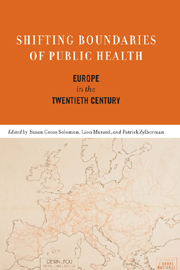Book contents
- Frontmatter
- Contents
- Preface
- Introduction
- Part One Place as Politics
- Part Two Carving Out the International
- Part Three Preserving the Local
- 6 Designs within Disorder: International Conferences on Rural Health Care and the Art of the Local, 1931–39
- 7 Contested Spaces: Models of Public Health in Occupied Germany
- 8 British Public Health and the Problem of Local Demographic Structure
- Part Four Navigating between International and Local
- Selected Bibliography
- List of Contributors
- Index
7 - Contested Spaces: Models of Public Health in Occupied Germany
from Part Three - Preserving the Local
Published online by Cambridge University Press: 12 September 2012
- Frontmatter
- Contents
- Preface
- Introduction
- Part One Place as Politics
- Part Two Carving Out the International
- Part Three Preserving the Local
- 6 Designs within Disorder: International Conferences on Rural Health Care and the Art of the Local, 1931–39
- 7 Contested Spaces: Models of Public Health in Occupied Germany
- 8 British Public Health and the Problem of Local Demographic Structure
- Part Four Navigating between International and Local
- Selected Bibliography
- List of Contributors
- Index
Summary
The year 1945 and the end of World War II in Germany is often called the Stunde null, or “Zero Hour.” According to this myth, following the liberation of the German population from fascism, Germany returned to democracy with the assistance of the Allies in the heart of Europe. Only the “Eastern Zone” under Soviet control maintained structures dating from the Nazi dictatorship. This account, however, is not supported by the historical sources. A study of the models of public health in occupied Germany shows that the governing authorities in both the Eastern and Western zones drew on traditions that dated back to the Weimar Republic and beyond, but emphasized different aspects of the traditions.
In the aftermath of the war, living conditions and the provision of medical care became increasingly precarious. The medical infrastructure had collapsed, resulting in catastrophic health conditions among the population. Many hospitals were destroyed, and medicines and medical supplies were scarce. A housing shortage, poor sanitation, and large numbers of refugees led to the spread of contagious disease and epidemics. The main goal of both the Allied authorities and the staff in the East and West German health administrations was to prevent an increase in infant mortality and to halt the spread of infectious disease and epidemics, including tuberculosis, typhus, dysentery, and sexually transmitted diseases. The Allied health-policy objective was to establish a medical, organizational, institutional, and legal framework to prevent the spread of diseases that would imperil the health of both the population and the occupying authorities.
- Type
- Chapter
- Information
- Shifting Boundaries of Public HealthEurope in the Twentieth Century, pp. 175 - 204Publisher: Boydell & BrewerPrint publication year: 2008

